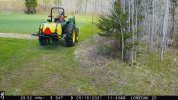-
If you are posting pictures, and they aren't posting in the correct orientation, please flush your browser cache and try again.
Edge
Safari/iOS
Chrome
You are using an out of date browser. It may not display this or other websites correctly.
You should upgrade or use an alternative browser.
You should upgrade or use an alternative browser.
Cleth vs Pursuit for clover
- Thread starter Rakman
- Start date
bigboreblr
5 year old buck +
clethodim is used to control grass in many vegetable crops. Clvoer tolerates it, but can be burned a bit from the surfactant you need to use.
I never used pursuit, but its a whole different animal. control broadleaf weeds, and some grasses and sedges.
Overall, take care of them soon. weeds are easy to handle when small. Take a pic of your problem child weeds. It's best to ID what you have for sure, so you know what your fighting.
I never used pursuit, but its a whole different animal. control broadleaf weeds, and some grasses and sedges.
Overall, take care of them soon. weeds are easy to handle when small. Take a pic of your problem child weeds. It's best to ID what you have for sure, so you know what your fighting.
FarmerDan
5 year old buck +
Not meaning to be a wise guy, but if you have to ask then you probably want to stick with clethodim. It and Pursuit are two different animals.Which should be used when for clover plots, white varieties specifically? Thank you
Sure I get what your saying. I should of phrased that differently & more specific to Pursuit. I have dealt with cleth before for grasses and understand it’s application.
I’ve not used persuit. I have a gallon. How would it be used in comparison to 24Db which I have used before for broadleaves.
I’d like to make use of the Pursuit if applicable for my farm.
I’ve not used persuit. I have a gallon. How would it be used in comparison to 24Db which I have used before for broadleaves.
I’d like to make use of the Pursuit if applicable for my farm.
FarmerDan
5 year old buck +
I think with both Pursuit and 2,4db timing is critical or to say it another way the chance of not getting the broadleaf control you expect is great and used improperly the possibility of damaging clover needs to be considered. Me, I'm not too worried about using either opting for some other means of broadleaf restraint. The broadleaf that hounds me is smartweed. I'll turn to Imox for it.Sure I get what your saying. I should of phrased that differently & more specific to Pursuit. I have dealt with cleth before for grasses and understand it’s application.
I’ve not used persuit. I have a gallon. How would it be used in comparison to 24Db which I have used before for broadleaves.
I’d like to make use of the Pursuit if applicable for my farm.
Here's part of the Pursuit label. Any deviation from this leaves your clover vulnerable. And, to be honest, the same could be said for 2,4 db.

Nightvision
5 year old buck +
Google Pursuit product label. Will tell you all you need to know.
If I had used it before and knew the answer I would tell you.
If I had used it before and knew the answer I would tell you.
yoderjac
5 year old buck +
Neither in my opinion. If clover is planted in the fall with a WR nurse crop and mowed the first spring, it should establish well. I become weed tolerant after that. I just mow once a year before the fall season. When the cool nights and fall rains favor clover, it rebounds and takes over the field. After many years (5 to 10+) depending on the clover variety, the N fixed into the soil has attracted enough grass in the field that you end up will little clover. At that point, it is much better to rotate the field into an N seeking crop for a season or two before rotating back to clover.Which should be used when for clover plots, white varieties specifically? Thank you
Spraying grasses in clover is an expensive loosing battle. Deer don't care. Many broadleaf weeds are very good deer food.
Wild Thing
5 year old buck +
I often drill rye into my clover in the fall for added fall forage. In mid-late May I spray a light dose (3/4 qt/acre) of Glyphosate over my clovers. It nukes the rye and any other grasses plus dandelions and any other broadleafs that may start coming up. The gly may set the clovers back a little but they rebound quickly. Clovers aren’t quite Roundup Ready but they are very roundup resistant. Try killing clovers with a quart to 1 1/2 quarts/acre and see how much clover survives - you will see what I mean.
yoderjac
5 year old buck +
I often drill rye into my clover in the fall for added fall forage. In mid-late May I spray a light dose (3/4 qt/acre) of Glyphosate over my clovers. It nukes the rye and any other grasses plus dandelions and any other broadleafs that may start coming up. The gly may set the clovers back a little but they rebound quickly. Clovers aren’t quite Roundup Ready but they are very roundup resistant. Try killing clovers with a quart to 1 1/2 quarts/acre and see how much clover survives - you will see what I mean.
I'd be careful with that. I've done it and it works great but with 1 qt/ac. I want to top kill the clover to give the stuff I drill time to germinate. I do advise caution, especially for folks in ag areas where gly resistance is a problem. Using light applications encourages gly resistance.
I may do this once in the life of a clover field when it is very weedy and I don't have time to rotate into another crop.
If I want to drill into clover, I find it much less risk to use a bushhog. You set it so low it is almost scalping the ground. That suppresses the clover enough for the drilled crop to germinate. My favorite is WR/GHR. This accomplishes the same thing with much less risk.
Thanks,
Jack
Wild Thing
5 year old buck +
I‘ve been doing it for years with no issues. YMMVI'd be careful with that. I've done it and it works great but with 1 qt/ac. I want to top kill the clover to give the stuff I drill time to germinate. I do advise caution, especially for folks in ag areas where gly resistance is a problem. Using light applications encourages gly resistance.
I may do this once in the life of a clover field when it is very weedy and I don't have time to rotate into another crop.
If I want to drill into clover, I find it much less risk to use a bushhog. You set it so low it is almost scalping the ground. That suppresses the clover enough for the drilled crop to germinate. My favorite is WR/GHR. This accomplishes the same thing with much less risk.
Thanks,
Jack
yoderjac
5 year old buck +
You don't have issues until you have them. Light use of herbicides is not a good practice. I'm not saying it doesn't work. From my post above, you can see I've done it. I'm saying that every species of weed has members of the cohort that are more resistant to a herbicide (gly in this case) than others. A light application will kill those members that are the least resistant to it but a light dose may not kill a few of the most resistant members of the cohort. When this is dome repeatedly, over time, the genetics of the most resistant are passed on. Eventually we develop weeds that are gly-resistant.I‘ve been doing it for years with no issues. YMMV
Even when herbicides are used according to the label, over a long period this will happen but it takes much longer. Gly-resistance has become a problem in ag over the years to the point farmers now have to turn to alternatives. Eventually Liberty will see the same fate.
I just want to make sure new folks understand the risks.
Thanks,
Jack
FarmerDan
5 year old buck +
I have done it successfully and I have done it where everything got fried. It's a gamble.I‘ve been doing it for years with no issues. YMMV
Wild Thing
5 year old buck +
You don't have issues until you have them. Light use of herbicides is not a good practice. I'm not saying it doesn't work. From my post above, you can see I've done it. I'm saying that every species of weed has members of the cohort that are more resistant to a herbicide (gly in this case) than others. A light application will kill those members that are the least resistant to it but a light dose may not kill a few of the most resistant members of the cohort. When this is dome repeatedly, over time, the genetics of the most resistant are passed on. Eventually we develop weeds that are gly-resistant.
Even when herbicides are used according to the label, over a long period this will happen but it takes much longer. Gly-resistance has become a problem in ag over the years to the point farmers now have to turn to alternatives. Eventually Liberty will see the same fate.
I just want to make sure new folks understand the risks.
Thanks,
Jack
I have done it successfully and I have done it where everything got fried. It's a gamble.
All I can say is that it works very well here in Michigan. Lots of others on the Michigan Sportsman forum besides myself have been successful with this method for years. Some use a full quart per acre and some of us use a lighter dose.
Ed Spinazzola recommended this in one his food plot books - either Ultimate Deer Food Plots or maybe his first book - Food Plots Easy as 1-2-3. For those that dont know Ed, he is a life-long Michigan farmer, former board member of QDMA and a well known authority on food plots for deer. He actually discovered this by accident. Nonetheless, it has worked very well for me for many years and I will be spraying my clovers again next month where needed on my farm.
If you don't feel comfortable spraying Gly on your clovers then, by all means, use Cleth & Crop Oil and 2-4,DB. It will do the same thing albeit, not as easily and at a much higher cost.
bigboreblr
5 year old buck +
rakman,
folks put small grains in their clover fields to use up excess nitrogen. Not only the small grains chokes out weeds early the next season, but it helps the clover climb up higher via trellacing.
Im new to using rye due to availability locally, but have used oats for a few years. The winter kills the oats, which may or may not be good for the clover in the spring.
Where I plant I have either heavily sandy soil or heavy clay soil at home. The added organic matter helps. I planted a extra tree or two in rows by my food plot at home. A new house was built and my in-laws didnt want to see the house. Day and night difference digging into the the semi-fallow field and the food plot next to it. Ease of digging and color of soil. It's only been 4 years at this place too.
I used clethodim to try to kill what I thought was "grass". Stuff is mace sedge though, clethodim did nothing to it. Wait till seed start to appear to Id it well. r cage in a spot to see what grows and what the wildlife eats.
folks put small grains in their clover fields to use up excess nitrogen. Not only the small grains chokes out weeds early the next season, but it helps the clover climb up higher via trellacing.
Im new to using rye due to availability locally, but have used oats for a few years. The winter kills the oats, which may or may not be good for the clover in the spring.
Where I plant I have either heavily sandy soil or heavy clay soil at home. The added organic matter helps. I planted a extra tree or two in rows by my food plot at home. A new house was built and my in-laws didnt want to see the house. Day and night difference digging into the the semi-fallow field and the food plot next to it. Ease of digging and color of soil. It's only been 4 years at this place too.
I used clethodim to try to kill what I thought was "grass". Stuff is mace sedge though, clethodim did nothing to it. Wait till seed start to appear to Id it well. r cage in a spot to see what grows and what the wildlife eats.
yoderjac
5 year old buck +
Just two thoughts:All I can say is that it works very well here in Michigan. Lots of others on the Michigan Sportsman forum besides myself have been successful with this method for years. Some use a full quart per acre and some of us use a lighter dose.
Ed Spinazzola recommended this in one his food plot books - either Ultimate Deer Food Plots or maybe his first book - Food Plots Easy as 1-2-3. For those that dont know Ed, he is a life-long Michigan farmer, former board member of QDMA and a well known authority on food plots for deer. He actually discovered this by accident. Nonetheless, it has worked very well for me for many years and I will be spraying my clovers again next month where needed on my farm.
If you don't feel comfortable spraying Gly on your clovers then, by all means, use Cleth & Crop Oil and 2-4,DB. It will do the same thing albeit, not as easily and at a much higher cost.
1) Timing is key. Clover is stressed a lot by the herbicide. If you get favorable conditions for clover it works great. If you get a drought or other stressor following the topkill, you can get some bad results.
2) Ed Spin's book and recommendation was a long time ago, before gly resistance became such an issue.
Wild Thing
5 year old buck +
Just two thoughts:
1) Timing is key. Clover is stressed a lot by the herbicide. If you get favorable conditions for clover it works great. If you get a drought or other stressor following the topkill, you can get some bad results.
2) Ed Spin's book and recommendation was a long time ago, before gly resistance became such an issue.
Just 2 replies to your two thoughts Jack:
1) Yes - Timing is key. In case you missed it, I treat my clovers once each year in May. Drought is not a factor in northern Michigan in May. If we are going to have a drought it will be in July or August. My clovers are green and lush in May - you can take that to the bank.
2) I had almost forgotten how long ago it was that Ed Spinazzola's book was published - 2006. So that is how long I have been successfully treating my clovers with Glyphosate….and I have yet to experience any gly resistance. If there is any gly resistance, it is the clovers that are gly resistant. If I wanted to kill my clovers I would treat them with 2-4,D or a heavy dose of gly - like 1 1/2 - 2 quarts/acre, which is 2 or 3 times the rate that I use for my annual maintenance spray.
Perhaps this type of maintenance won‘t work well in your clovers down south where your farm is, but it works remarkably well on my farm in Northern Michigan and has for many years. As I mentioned previously, if anyone doesn't feel confident in this method I would encourage them to try some other alternative.
yoderjac
5 year old buck +
Gly-resistance is really area dependent. In areas with a lot of ag RR bean/corn rotations it can be quite high. I'm not suggesting that you shouldn't do it or it doesn't work. It works. So does a 2 bottom plow and disc for soil prep. For many years you can get great results, especially on highly fertile soils. However, eventually the degradation to soil health evidences itself. You don't have problems until you have them. IF you do, at least for now, you can buy your way out by paying more for Liberty when gly-resistance becomes a problem.Just 2 replies to your two thoughts Jack:
1) Yes - Timing is key. In case you missed it, I treat my clovers once each year in May. Drought is not a factor in northern Michigan in May. If we are going to have a drought it will be in July or August. My clovers are green and lush in May - you can take that to the bank.
2) I had almost forgotten how long ago it was that Ed Spinazzola's book was published - 2006. So that is how long I have been successfully treating my clovers with Glyphosate….and I have yet to experience any gly resistance. If there is any gly resistance, it is the clovers that are gly resistant. If I wanted to kill my clovers I would treat them with 2-4,D or a heavy dose of gly - like 1 1/2 - 2 quarts/acre, which is 2 or 3 times the rate that I use for my annual maintenance spray.
Perhaps this type of maintenance won‘t work well in your clovers down south where your farm is, but it works remarkably well on my farm in Northern Michigan and has for many years. As I mentioned previously, if anyone doesn't feel confident in this method I would encourage them to try some other alternative.
For me, following best practices, minimizing tillage, and rotating to N-seeking crops rather than trying to extend the life of a clover field or make it "magazine picture ready" is a much better approach. Anything that doesn't end up in the stomach of a deer is not contributing to my QDM. A field that is 50% weeds and 50% clover is even more attractive to deer than a flat field of clover.
Thanks,
Jack
Wild Thing
5 year old buck +
For those of you who may be interested in trying Glyphosate for clover as an alternative, I found a few photos from last year.
I plant clover strips around the outside edge of all of my food plots. Not sure where all the dandelions came from last year but this photo was taken on May 12th:
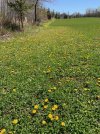
This is another food plot with the photo taken on May 12th as well.
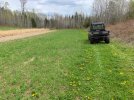
On May 16th (note date stamp on trail cam photo) I sprayed these clover strips at a rate of 24 oz/acre (3/4 qt) per acre of 41% Glyphosate.
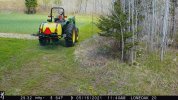
This is the same clover strip as in the top photo on June 16th - 1 month after spraying Gly (I had sprayed the cover crop and drilled sugar beets in the 1 acre plot on the left on May 18th)
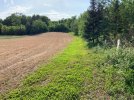
This is the second plot (2nd photo from top) one month later on June 16th.
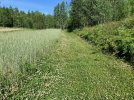
No dandelions....no grasses....no other broadleaf weeds....nothing but clover 1 month after spraying with Gly. I do this in my clover strips that need it (every year or two) and have been successfully doing this for many years. I have never nuked the clover and I have no Gly tolerance issues with any other weeds or grasses. Once again - YMMV depending upon your conditions in your dirt.
I plant clover strips around the outside edge of all of my food plots. Not sure where all the dandelions came from last year but this photo was taken on May 12th:

This is another food plot with the photo taken on May 12th as well.

On May 16th (note date stamp on trail cam photo) I sprayed these clover strips at a rate of 24 oz/acre (3/4 qt) per acre of 41% Glyphosate.

This is the same clover strip as in the top photo on June 16th - 1 month after spraying Gly (I had sprayed the cover crop and drilled sugar beets in the 1 acre plot on the left on May 18th)

This is the second plot (2nd photo from top) one month later on June 16th.

No dandelions....no grasses....no other broadleaf weeds....nothing but clover 1 month after spraying with Gly. I do this in my clover strips that need it (every year or two) and have been successfully doing this for many years. I have never nuked the clover and I have no Gly tolerance issues with any other weeds or grasses. Once again - YMMV depending upon your conditions in your dirt.
Attachments
yoderjac
5 year old buck +
No doubt it works if you get the timing right. I've posted this before, but here is an example of of field where 1/2 the field the clover was suppressed with 1 qt/ac gly. The other half was suppressed by bushhogging it flat. Then I drilled Groundhog radish into the field.For those of you who may be interested in trying Glyphosate for clover as an alternative, I found a few photos from last year.
I plant clover strips around the outside edge of all of my food plots. Not sure where all the dandelions came from last year but this photo was taken on May 12th:
View attachment 42737
This is another food plot with the photo taken on May 12th as well.
View attachment 42738
On May 16th (note date stamp on trail cam photo) I sprayed these clover strips at a rate of 24 oz/acre (3/4 qt) per acre of 41% Glyphosate.
View attachment 42740
This is the same clover strip as in the top photo on June 16th - 1 month after spraying Gly (I had sprayed the cover crop and drilled sugar beets in the 1 acre plot on the left on May 18th)
View attachment 42741
This is the second plot (2nd photo from top) one month later on June 16th.
View attachment 42742
No dandelions....no grasses....no other broadleaf weeds....nothing but clover 1 month after spraying with Gly. I do this in my clover strips that need it (every year or two) and have been successfully doing this for many years. I have never nuked the clover and I have no Gly tolerance issues with any other weeds or grasses. Once again - YMMV depending upon your conditions in your dirt.
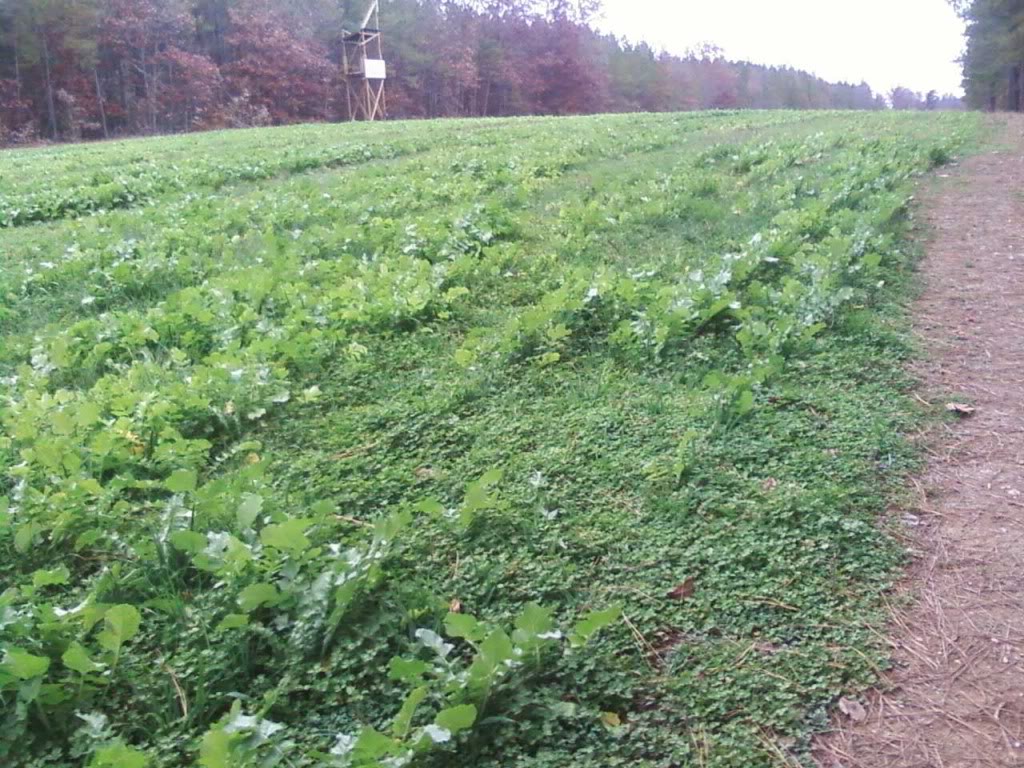
You can see how the radish germinated and then the clover bounced back and filled in. Here is a close up.
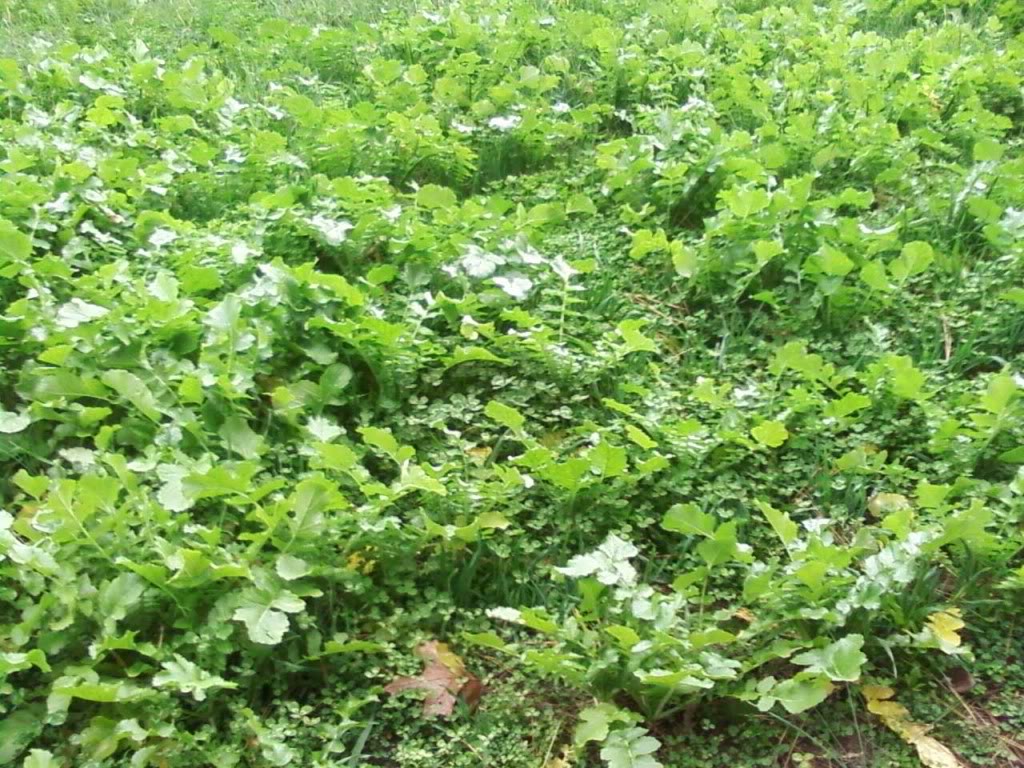
You can't tell any difference between the two sides of the field.
Lesson learned: You can accomplish the same thing using a technique that does not carry the risk of using light application of herbicides. It is also a lower cost approach and with Gly prices these days that's a plus. I just bought a 30 gal drum and it was $38/gal. Last year it was $14.
Thanks,
Jack

